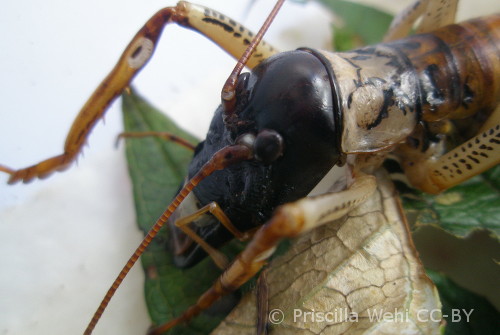Sexual dimorphism, behaviour and evolution
 Exaggerated weaponry may evolve as a result of sexual selection and provide a reproductive advantage in contests for mates. Weapons such as the huge mandibles seen in male tree wētā (Hemideina spp.) and used for fighting can attain enormous size. However, developing and bearing large weaponry can include tradeoffs such as increased predation risk, impaired locomotion or reduced immune responses. I and colleagues have investigated sexually-skewed predation by introduced mammals (Wehi et al. 2011). We are also examining ecological costs of this evolution, including on foraging and nutrition.
Exaggerated weaponry may evolve as a result of sexual selection and provide a reproductive advantage in contests for mates. Weapons such as the huge mandibles seen in male tree wētā (Hemideina spp.) and used for fighting can attain enormous size. However, developing and bearing large weaponry can include tradeoffs such as increased predation risk, impaired locomotion or reduced immune responses. I and colleagues have investigated sexually-skewed predation by introduced mammals (Wehi et al. 2011). We are also examining ecological costs of this evolution, including on foraging and nutrition.
Body size and male weaponry are morphological traits that have also been linked to environmental change. Body size strongly relates to individual fitness, and has profound physiological and ecological consequences. Sexual size dimorphism in a species may be affected by environmental conditions such as temperature or food availability, but effect of temperature in ectotherms still requires rigorous investigation. Males and females may also respond differentially to environmental conditions. Adult size in many species is modified along latitudinal and altitudinal gradients. I have built a large dataset of morphological and isotopic measurements for the sexually dimorphic tree wētā genus from localities and collections throughout New Zealand to explore the effects of environmental conditions on population phenotype, including diet-induced plasticity.
References
- Parli A, Besson A, Wehi PM, Johnson S 2020. Sub-lethal exposure to a vertebrate pesticide bait alters behaviour in an orthopteran. Journal of Insect Conservation (2020): 1-12 10.1007/s10841-020-00222-6
- Brown MBJG, Gemmill CEC, Miller S & Wehi PM 2018. Diet selectivity in a terrestrial forest invertebrate, the Auckland tree weta, across three habitat zones. Ecology and Evolution 8: 2495–2503. 10.1002/ece3.3763
- Wehi PM, Monks A & Morgan-Richards M 2017. Tree weta are attracted to cuticular scent cues but do not distinguish according to sex or among two closely-related species. Ethology 123: 825–834. 10.1111/eth.12652
- Morgan DKJ, Clapperton BK, Gillanders JA & Wehi PM 2017. The palatability of carrot surface-coated with repellents or dyed blue or green to a terrestrial macroinvertebrate. New Zealand Journal of Zoology 44: 212–224. 10.1080/03014223.2017.1289473
- Wehi PM, Jorgensen M & Morgan D 2015. Predictors of relative abundance of tree weta (Hemideina thoracica) in an urban forest remnant. New Zealand Journal of Ecology 39: 280–285.
- Wehi PM, Raubenheimer D & Morgan-Richards M 2013a. Tolerance for nutrient imbalance in an intermittently feeding herbivorous cricket, the Wellington tree weta PLOS ONE 8(12): e84641. 10.1371/journal.pone.0084641
- Wehi PM, Jorgensen M & Morgan-Richards M 2013b. Sex- and season-dependent behaviour in a flightless insect, the Auckland tree weta (Hemideina thoracica). New Zealand Journal of Ecology 37: 75–83.
- Wehi PM, Nakagawa S, Trewick S & Morgan-Richards M. 2011. Does predation result in adult sex ratio skew in a sexually dimorphic genus? Journal of Evolutionary Biology 24:2321-2328 [featured on the cover, issue 24 (11)]. 10.1111/j.1420-9101.2011.02366.x
- Griffin MJ, Trewick SA, Wehi PM & Morgan-Richards M 2011. “Invertebrate mice”: Exploring the concept of niche convergence in a land without rodents. New Zealand Journal of Ecology 35: 302-307.
- Wehi PM & Hicks BJ 2010. Isotopic fractionation and trophic enrichment in the Auckland tree weta, a large herbivorous insect. Journal of Insect Physiology 56: 1877–1882. 10.1016/j.jinsphys.2010.08.005